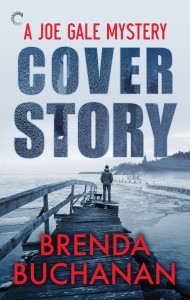Kathy Lynn Emerson's Blog, page 94
September 30, 2015
Kathy’s Great Adventure
Kathy Lynn Emerson/Kaitlyn Dunnett here. The first thing you have to know about me is that I’m a chicken. The second thing is that I’m a worrier. Combine these two and you get a certain reluctance to try new things, especially on my own. I don’t think this is particularly uncommon, especially among women whose husbands are obliging enough to offer to drive when a trip of any distance is in the offing. I’m happy to have company and he sees better at night than I do. Over the last few years, I’ve hardly ever driven myself farther from home than the post office or the grocery store.

helping me get ready to go
Then two events coincided. The first was the scheduling of my fiftieth high school reunion for September 25-27 in Liberty, New York, about an eight-hour drive from where I now live if you take all the high-speed roads available. The second was the dawning of an idea for a new contemporary mystery series, one in which a woman of my years is starting over on her own, making a major move as well as a career change. The next step seemed inevitable—I would have to get myself to that reunion. On my own. By myself.

a younger, braver me
Did I mention that I always go to full service gas stations and let someone else pump the gas? Or that I have a terrible track record when it comes to successfully swiping credit cards? Or that I have some physical challenges thanks to arthritis in my hands, knees, neck, and ankles? Never mind. I decided that if my protagonist could be my age and manage on her own, so could I. Any fumbles along the way would just have to become fodder for comic relief.
Because the new setting will be a small town, but this time not in Maine, I opted to take the scenic route through New Hampshire and Vermont and avoid the Thruway once I hit New York. This, of course, added time, if not miles, to the trip. Since I can’t do anything about that bad night vision, that meant taking two days for the drive with stops to explore along the way and look for details that may become part of my fictional setting. I expected this to be full-blown leaf-peeper season. Not this year. Still, it was a pretty drive.
It was also a long haul: five and a half hours the first day and nearly five the second.

the house I grew up in
Both Liberty, New York and Wilton, Maine are in the foothills of the mountains. In fact, the land looks remarkably similar, except that New York allows billboards and Maine does not. But there is one area where there are some distinct differences—how a murder investigation is handled. In Maine, the State Police step in at once, except in Portland and Bangor. In New York, it depends. Fortunately, one of my high school classmates has a son who is a Sullivan County Deputy Sheriff and he agreed to be my local law enforcement expert. We met the first afternoon I was in town and talked shop over McNuggets, fries, and a very large coffee to keep me going through the evening ahead. Yes, of course, my new sleuth will be an amateur, but there’s nothing worse than getting the details wrong and every state handles criminal investigations just a little bit differently.
 Aside from reunion activities, there was one other addition to my personal schedule. I wanted to donate some of my books to the local library. To be honest, I was trying to clear some space for the boxes of new ones that have already begun arriving—the paperback of Ho-Ho-Homicide, the hardcover of The Scottie Barked at Midnight, the trade paperback of Murder in the Queen’s Wardrobe, and the hardcover of Murder in the Merchant’s Hall. However, when the librarian responded by asking me to do a talk and signing while I was in town, I didn’t exactly run the other way. I set out with a very full car trunk—two boxes of books for the library, four boxes of books to offer for sale (two oldies set in Liberty and the two most recent titles), and four more boxes filled with extra copies of a few of my older books to offer as freebies to classmates. I still had room left for a suitcase and a cooler for snacks and a tote with necessities: folder with information and maps, (I do not and will not use GPS!), change for the book signing, and the one thing I can no longer live without—my iPad. When my character makes the trip, she’ll also have to find space for a litter pan and feline necessities since she’ll be traveling with at least one cat.
Aside from reunion activities, there was one other addition to my personal schedule. I wanted to donate some of my books to the local library. To be honest, I was trying to clear some space for the boxes of new ones that have already begun arriving—the paperback of Ho-Ho-Homicide, the hardcover of The Scottie Barked at Midnight, the trade paperback of Murder in the Queen’s Wardrobe, and the hardcover of Murder in the Merchant’s Hall. However, when the librarian responded by asking me to do a talk and signing while I was in town, I didn’t exactly run the other way. I set out with a very full car trunk—two boxes of books for the library, four boxes of books to offer for sale (two oldies set in Liberty and the two most recent titles), and four more boxes filled with extra copies of a few of my older books to offer as freebies to classmates. I still had room left for a suitcase and a cooler for snacks and a tote with necessities: folder with information and maps, (I do not and will not use GPS!), change for the book signing, and the one thing I can no longer live without—my iPad. When my character makes the trip, she’ll also have to find space for a litter pan and feline necessities since she’ll be traveling with at least one cat.
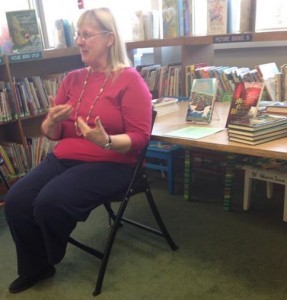 So, how did it go, you ask? Just great. When I couldn’t find gas stations with full service pumps, I managed to con other people into pumping gas for me (dithery females of a certain age can get away with a lot!). I renewed old friendships, visited familiar places, took note of changes the last fifty years have wrought, and generally enjoyed myself. The library talk was well attended, both by classmates and others. The two gatherings of the class, a Friday night icebreaker and a Saturday night banquet, were both fun. Thank goodness, though, for name tags!
So, how did it go, you ask? Just great. When I couldn’t find gas stations with full service pumps, I managed to con other people into pumping gas for me (dithery females of a certain age can get away with a lot!). I renewed old friendships, visited familiar places, took note of changes the last fifty years have wrought, and generally enjoyed myself. The library talk was well attended, both by classmates and others. The two gatherings of the class, a Friday night icebreaker and a Saturday night banquet, were both fun. Thank goodness, though, for name tags!
If you’re looking for me in the above photo, here’s a hint: only my nose is showing.
Back home again, I’m slowly catching up and getting back into my normal routine. I was fine as long as I kept going. It’s stopping that’s the killer. I still feel as if I could sleep for a week, but no rest for the wicked. Less than a week from now, I’m off to Bouchercon, another reunion of sorts, this one with fellow mystery writers and readers.
Kathy Lynn Emerson/Kaitlyn Dunnett is the author of over fifty books written under several names. She won the Agatha Award in 2008 for best mystery nonfiction for How to Write Killer Historical Mysteries and was an Agatha Award finalist in 2014 in the best mystery short story category for “The Blessing Witch.” Currently she writes the contemporary Liss MacCrimmon Mysteries (The Scottie Barked at Midnight) as Kaitlyn and the historical Mistress Jaffrey Mysteries as Kathy (Murder in the Merchant’s Hall). The latter series is a spin-off from her earlier “Face Down” series and is set in Elizabethan England. Her websites are www.KaitlynDunnett.com and www.KathyLynnEmerson.com
September 29, 2015
Cooking Up a Good Villain
Kate Flora: Yes. You read that right. I’ve often written here, and elsewhere, about the  importance of taking chances and how chance taking can have a surprisingly positive effect on writing and a writer’s career. Sometimes, as in the creation of Beat, Slay, Love, the group novel by the pseudonymous Thalia Filbert, which debuts tomorrow, the process is not just a positive adventure that stretches me as a writer, it is downright good fun. And a big part of that fun was constructing the scenarios in which famous TV chefs are killed, and the apparently invisible villain who is killing them.
importance of taking chances and how chance taking can have a surprisingly positive effect on writing and a writer’s career. Sometimes, as in the creation of Beat, Slay, Love, the group novel by the pseudonymous Thalia Filbert, which debuts tomorrow, the process is not just a positive adventure that stretches me as a writer, it is downright good fun. And a big part of that fun was constructing the scenarios in which famous TV chefs are killed, and the apparently invisible villain who is killing them.
Fun, you say? Since when is writing fun? Isn’t writing supposed to be a grueling activity that makes your bottom spread as you spend those endless hours at the keyboard and concentrate until drops of blood appear on your forehead? Well. Yes. That’s part of it. Maybe that’s most of it, a truth that is revealed if I back toward a mirror or swipe at my forehead. But writing can also be a whole lot of fun. Especially if it is done with the right group of people.
 Here’s how it all came about. (Though I’m betting each of the five of us who are Thalia Filbert will tell a slightly different version of the story.) One day I got an e-mail asking if I’d like to join some other writers in a blog group. After I got over the idea of cheating on Maine Crime Writers, I said yes. This group is made up of writers I’ve known since my beginnings in this business more than twenty years ago. We’re spread all over the country. I respected them and thought it could be an interesting adventure. Not long after we started blogging together, on a blog called “Views from the Muse,” someone suggested it would be fun to put together a crime story anthology. The result was Dead of Winter http://amzn.to/1MXFLh1
Here’s how it all came about. (Though I’m betting each of the five of us who are Thalia Filbert will tell a slightly different version of the story.) One day I got an e-mail asking if I’d like to join some other writers in a blog group. After I got over the idea of cheating on Maine Crime Writers, I said yes. This group is made up of writers I’ve known since my beginnings in this business more than twenty years ago. We’re spread all over the country. I respected them and thought it could be an interesting adventure. Not long after we started blogging together, on a blog called “Views from the Muse,” someone suggested it would be fun to put together a crime story anthology. The result was Dead of Winter http://amzn.to/1MXFLh1
That was a lot of fun and the book was good, so naturally someone asked what we might do next. As we all jokingly now say—the next obvious thing to do was write a group novel. But how could we write a group novel, given the very different things we were writing, and what would it be about?
Here are the players:
Gary Phillips writes hardboiled tales of flawed characters and their pursuit of hollow dreams. In addition to being part of the Beat, Slay, Love crew, he is co-editor of Occupied Earth, an anthology of life and resistance under the boot heels of the alien Mahk-Ra.
Katy Munger has written fifteen crime fiction novels, including series in the cozy, private eye, and modern noir genres. She was a co-founder of Tart Noir.
Lise McClendon writes mystery and suspense, celebrating 20 years in print last year. Her series include an art dealer in Jackson Hole, a private eye in Kansas City, and a lawyer with five sisters in France. She also writes thrillers as Rory Tate (PLAN X) and co-owns Thalia Press with Katy Munger. http://lisemcclendon.com
Taffy Cannon has written a mainstream novel, thirteen mysteries, an Academy Award-nominated short film, and The Baby Boomer’s Guide to SibCare.
Kate Flora writes two series—strong, amateur, female PI in her Thea Kozak series and cops in her Joe Burgess police procedurals. She’s published more than fifteen crime stories. She’s been a publisher at Level Best Books and teaches writing at Grub Street in Boston.
Somehow, the topic became a serial killer, traveling the country killing off celebrity chefs,
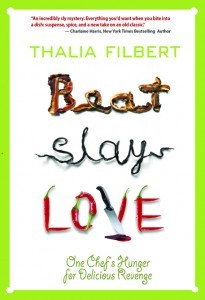
Bacon, squid ink pasta, and hot peppers!
and our villain was born. Actually, she was more of a Frankenstein creation, with everyone contributing pieces, then written, tweaked, augmented, revised, and redescribed until everyone was satisfied. As motivation, she was given such a backstory of mistreatments and misadventures that she couldn’t help but want delicious revenge on those who had abused her. Imagine, if you can, having not one but five pen pals, and when their letters arrive, they come as chapters in an ever-unfolding adventure. An unfolding serial that we both read and wrote. That was Beat, Slay, Love, a story Charlaine Harris calls “an incredibly sly mystery.”
Oh, and the cover lettering? Real bacon, squid ink pasta, and red peppers. How culinary is that?
Read an excerpt from the book here:
To celebrate we’ve put together a cookbook of party recipes called Thalia Filbert’s Killer Cocktail Party. To get a copy, send a quick note to Thalia (our pseudonymous five-person author) at thaliapress@gmail.com.
Beat Slay Love: One Chef’s Hunger for Delicious Revenge by Thalia Filbert
Thalia Press October 1, 2015
To order the book for Kindle: http://www.amazon.com/gp/product/B015BQUZCK
To add it to your Goodreads shelf: https://www.goodreads.com/book/show/26258450-beat-slay-love
To request a paperback at your local independent bookstore: ask for ISBN: 978-0-9819442-1-0
To buy a paperback online: https://www.createspace.com/5737186
The Writer’s Life, getting published and the secret to achieving it
Hi all, Maureen Milliken here, comtemplating The Writer’s Life.
Yes, I know I put that in caps. That’s because it’s the name of a Thomas College class I’ve been asked to be a guest speaker at in a couple weeks. As always, I look forward to any opportunity where I’m actually being asked to speak. Usually I’m being asked to stop.
But what to say about The Writer’s Life? Or even the writer’s life? No writer’s life is the same, and I always feel when people want to hear about it — and maybe I was like this too before I was published — they want to come away with a tip sheet, or even just one magic tip, that will lead directly to publishing success. Ugh.
I’m not sure what my fantasy of the writer’s life was. I’ve wanted to write mystery novels almost since I was able to read. I think my fantasy involved the actual writing more than “being a writer.” But I know there WAS a period of time I also fantasized about being on the Dick Cavett Show. I was probably 12 or 13 or so and had a mini-crush on Dick. He

Dick Cavett. I think we all can agree that Dick looks like he’s saying, “You know, Maureen, I found your book fascinating.”
just always seemed so interested in what his guests had to say — a novelty for me (again, used to being asked to stop speaking). And he was so smart, but he acted like his guests were smart, too. And something about his voice. Instantly recognizable and so, so…something. Every once in a while I’ll hear Dick Cavett’s voice on TV or somewhere and it gives me a pleasant shiver.
I haven’t fantasized about being on Dick Cavett in a good 40 years or so. I’m going to try now. Dick: So Maureen (he knows my name!), I don’t understand this plot point having to do with the bridge and the…
Oh, nuts. Dick has turned into the guy who accosted me in the community center parking lot after the recent town meeting (voted to build a new town office!) and wanted to wrangle over my major plot twist as his wife nervously kept saying, “Don’t bother her.”
Ah yes. The writer’s life.
Here’s what this writer’s life is like Aside from having more conversations than I ever could have imagined with people (who are not Dick Cavett) about my book and the finer points: I work long, long hours (gosh should actually be getting ready to go to work about

Everybody writes! As a judge in the Writers Digest self-published book contest, I ‘ve read and critiqued hundreds of self-pubs over the last few years.
half an hour ago) at a job I love but takes every ounce of my physical and mental strength to do. I do freelance editing and judge in the Writer’s Digest self-published book contest to help pay the bills, which means reading as many as a couple hundred self-published books a year and then critiquing them. Sometimes I try to do things like clean my house, read a book for pleasure, keep up on the news, do things with family and friends and tend to my dog and cat. When I can fit it in.
So when do I find the time to write the next book, which is due with the publisher, um, sometime soon? Good question.
I’m not complaining, just explaining. As an only recently published writer, I can say forcefully that no one wants to hear someone whose book has been published complain about what a burden it is.
Anyway, everyone’s got it tough in one way or another. The writer’s life is as diverse as the writers themselves. I was fortunate to hang out with a bunch of mystery writers in Bar
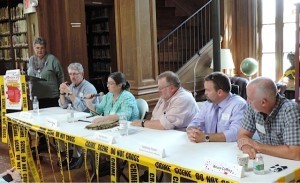
Can I talk? You betcha. I won’t give up the mike at the Jesup Library’s Murder by the Book, The Real World vs. The Page panel: Maine Superior Court Justice William Stokes, journalists Maureen Milliken and Earl Brechlin, Hancock County District Attorney Matthew Foster and retired Portland Det. Sgt. Bruce Coffin
Harbor at the Jesup Library’s Murder by the Book event earlier this month, and was struck by the different lives each of the dozen authors at the event leads. Lots and lots of lawyers and former lawyers. But still, wildly different lives. Lives as different as the books we write.
But I bet every single person who writes has his or her challenges when it comes time to do it. I’m happily single, but there are times I wish there was someone around to clean the house — those week-old dishes aren’t going to wash themselves! — or go to the store or walk the dog. Or even bankroll my career.
Then I laugh. The last thing I need is someone lounging on the couch clicking through 570 TV channels and leaving his socks on the floor while I’m trying to write. But I digress.
So far, I’ve thought of two BIG THINGS to tell the eager students at Thomas College. Two nuggets of wisdom that apply to every aspiring writer, no matter what his or her life is or may become.
First thing is, write. Write write write write write. Don’t let the excuses, the challenges, the dishes in the sink or the need to make a buck deter you. Buck up, knuckle down, shut your pie hole and write.
Second: Don’t give up. Make sure it’s as good as it can possibly be and then plug away, graciously but persistently, with conferences, agents, publishers big and small, learning the craft and how things work, until someone who’s willing to pay for it likes your book as much as you do. If your book is worthy and you behave professionally, there is no other secret to getting published.
Oh yeah, I guess there’s a third. Never ever ever, no matter how hard it is, forget what a
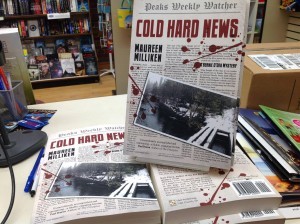
This never stops being cool: Cold Hard News on display at The Book Cellar in Waterville, Maine.
huge privilege it is to see your book in print. Be thankful and gracious to every single person who buys it, asks you to sign it, or even wants to argue plot points with you in the community center parking lot. Remember, there are hundreds of thousands of people out there who wish they were you but haven’t done what you did — written a book good enough to get published.
And that’s the best damn thing about a writer’s life.
Maureen Milliken is a newspaper editor in central Maine and the author of Cold Hard News, which was released by S&H Publishing in June. Follow her on Twitter at @mmilliken47 or check out her Facebook page, Maureen Milliken mysteries.
September 27, 2015
Visiting Your Story’s Location
Lea Wait, here.
At a recent mystery conference I spoke on a panel titled “Research.” While I was preparing notes on that topic I asked my Facebook friends what they’d be interested in knowing about research. Amy Reade asked, “Do you have to visit places you write about?”
Without dealing with the question of fictional locations (which still have to remain true in all ways to the area where they’re set), my answer is a definite “yes.” And then I’ll add a “but.”
BUT … I’d strongly advise doing a lot of homework before you set your GPS or buy your plane ticket. First, I’m assuming you have a definite reason your story has to take place in a certain location. (I’ve set contemporary books on Prouts Neck, in Maine, in central New Jersey, and at the Duchess County Fairground in New York State as well as in Maine. My characters in historicals have lived in or visited Saratoga, New York, Charleston, South Carolina, and Edinburgh, Scotland, among other places.)
I’ve lived in some of those locations; I visited the rest when I knew I’d be writing about them. But I spent months researching before I visited.
Why? Several reasons. First, my stories were set in history. Visiting those cities today wouldn’t show me what they looked like in 1805 or 1848, the years I was setting my stories. I wanted to know what the cities looked like in the past. I found maps, pictures, books on the histories of the cities, read other books set in those locations, and basically immersed myself in the food, climate, animals, plants and, of course, the people who lived there at that time.
After I felt I’d feel at home in that place, at that time, I went there with a list of specific places to see and questions to answer. I chose places for my characters to live. I visited local archives to see newspapers printed at the time. I took binders of notes. I walked the streets, tasted the food, and, in Charleston, even lived through a hurricane and visited homes that had been in Charleston when my characters lived there.
I immersed myself in the towns. I interviewed historians about specific questions I had, visited the locations my characters knew, and, perhaps most important, walked the streets and imagined the people in my book walking there.
I took pictures. I bought postcards. I bought local maps, books on local plants and animals and geology, and recipe books that dated to the past. (Used bookstores helped there.)
In no place I visited for the first time after researching it did I find it as I’d imagined it. No written sources I’d studied could tell me what color the cobblestones were, or how close the university felt to the area where my characters lived, or what tombstones were important in the local cemeteries … and how tall they were, and how weathered, and how the grounds were kept up and whether squirrels or cats lived there.. Yes, maps can tell you where streets are. But feeling how close buildings are to those streets, how high they are, where sunlight falls or shadows hide, is critical to making descriptions real.
So my answer to Amy, and everyone else who has asked, is simple.
Yes. Visit the places where your characters live. And even if you live in the same location as your characters, double check to make sure the right birds arrive at the right times, the right flowers bloom, and the right fish spawn.
Google maps can help, yes. But they can’t tell you the smells and sounds and feel of a place. They can’t tell you how living in a place can mold a character.
You need to get all those things right to make your story credible.
True – not every writer does. But how many times have you read a story or novel about a place you knew and found errors? Those errors take readers out of the story.
And you don’t want your readers to stop reading, do you?
September 26, 2015
Weekend Update: September 26-27, 2015
 Next week at Maine Crime Writers there will be posts by Lea Wait (Monday) Maureen Milliken (Tuesday), a mystery guest (Wednesday), Kaitlyn Dunnett/Kathy Lynn Emerson (Thursday) and Barb Ross (Friday).
Next week at Maine Crime Writers there will be posts by Lea Wait (Monday) Maureen Milliken (Tuesday), a mystery guest (Wednesday), Kaitlyn Dunnett/Kathy Lynn Emerson (Thursday) and Barb Ross (Friday).
In the news department, here’s what’s happening with some of us who blog regularly at Maine Crime Writers:
From Kathy Lynn Emerson/Kaitlyn Dunnett: Today, September 26, I’ll be doing a “chat with the author” and book signing at Liberty Public Library, Liberty, New York. That’s my old home town and I’m there for my high school reunion. Later in the week, I’ll be blogging about why else I’ve made this trip. Hint: it has something to do with finding the perfect small town setting for a cozy series.
Kate Flora: We are eager to hear about the adventure, and the reunion, and will be surprised if you don’t come home with a few story ideas.
And since last week I promised someone who commented would get a copy of Beat, Slay, Love, I must be a writer who keeps her word. Are you listening, Myrna Bouchard? And now I guess I’ll need your mailing address. And then, since giving gifts is so much fun…I’m going to give another copy away next week. So keep those comments coming, MCW fans!
An invitation to readers of this blog: Do you have news relating to Maine, Crime, or Writing? We’d love to hear from you. Just comment below to share.
And a reminder: If your library, school, or organization is looking for a speaker, we are often available to talk about the writing process, research, where we get our ideas, and other mysteries (and secrets) of the business. Contact Kate Flora: mailto: kateflora@gmail.com
September 25, 2015
Confessions of a Literary Coward
John Clark being completely honest about my fear of publishing today. I’ve been writing for at least twenty years, covering numerous categories and styles. I’ve written for professional publications in the library and social sciences field, contributed to a book on mental health libraries, written human interest stories about interesting people for newspapers, done several weekly columns for other newspapers, one running for five years. I’ve been in several of the Level Best anthologies and have had a couple mystery stories published in online magazines. I was a regular contributor to Wolf Moon Journal. In addition, I’ve written seven books and have four more in varying stages of completion, but only one has ever been published and that was in ebook format. There’s also an anthology of YA stories with a novella as a possible centerpiece called Hardscrabble Kids, that’s close to prime time.

Taking that next step can be scary.
So what’s stopping me from getting the rest of them out there? Well, that’s why I’m writing this today and if it sounds whiny at times, so be it. In partial defense, I will tell you that most small town librarians work about 15 hours more that they’re paid for and that’s what I’ve done for most of my writing life. Even so, I know that plenty of published/successful authors work full time and/or are parents of kids who need a lot of time if they’re going to grow up healthy and happy.
I’ve been thinking a lot about my five book series that took sixteen years to write and then I pretty much walked away from it. Who is crazy enough to do something like that? I hope that by blogging about it, I can get a better perspective and go back to doing something about getting the other four books out there.

Not exactly Cloudy With A Chance of Meatballs.
First a bit of history about the series and a quick bit about each book. The impetus to write fantasy came as much from my early years as anything. I read everything Edgar Rice Burroughs wrote when I was between ages nine and thirteen. Most think of Tarzan when his name comes up, but there were plenty of others. His John Carter and Carson of Venus series, the Moon books and ones like The Mad King, The Mucker and The Bandit of Hell’s Bend were my friends at a time when the real world was neither real or very friendly. Add in A.E. Van Vogt, Fletcher Pratt and L. Sprague DeCamp, Harry Harrison (The Stainless Steel Rat series) and my love of fantasy and Sci-Fi continued until college demanded that most of what I read be course related.
Shortly after Beth and I got married in 1977, a new series of fantasy debuted by an author named Stephen Donaldson. By the time he finished the second trilogy in the series, he had written some 2700 pages, created one of the most amazing worlds I’ve ever encountered and hooked me. However, Donaldson was so unsparing of his protagonist, Thomas Covenant, that I gave up reading the six books, not once, but twice. It took twenty years more or less, for me to finally read the last book (Donaldson has since written four more books in the series, but they weren’t published until 2004-13). I remain in awe of his ability to maintain consistency in such a complex world with many locations, races and myths. It is a series I will read at least one more time before I die.

When you’re not sure where your story is going, it’s good to trust that you’ll stay on track.
The day I finally finished White Gold Wielder I was sitting in the woods, ostensibly hunting deer. I found myself crying unashamedly as I closed the book and it was that moment which really got me started on the writing path.
The writing part began in a very odd way. At the time, I was actively involved in the Association of Mental Health Librarians (AMHL) as well as section chair of the mental health library group in the Medical Library Association (MLA). The two groups were involved in programs to be presented at their respective annual conferences and that, along with frequent postings on the Maine Library listserv-MELIBS, meant that I was sending out a lot of emails. By that point, one of my claims to fame was my email signatures. Sometime, not long after finishing book six, I began creating bits of dialogue that were attributed to a book called The Berek Chronicles. No such book existed, but it was fun and fairly harmless. Then some librarians, mostly in Maine, tried to get their hands on a copy of the book, but couldn’t find it. I was confronted at a meeting of librarians here in Maine and when I mumbled something to the effect that I was thinking about writing it, some of them politely said get my thumb out of my butt and do so.

In my series, Sennebec Lake was the model for Simonton Pond.
I probably broke every rule of writing along the way, from posting every chapter online (they’re long gone now), to printing out a copy of the manuscript and circulating it at the Boothbay Harbor Memorial Library (It was helpful in terms of getting feedback) and shopping it to agents when it was nowhere near ready for that level of evaluation. It was also way too long, close to 360,000 words at one point. Even so, I can still remember the amazing feeling that came over me when I completed the story. However, it wasn’t the ending, just part one because my protagonist, Berek Metcalf, a shy sixteen year old with an extra finger on one hand, woke up back in his bedroom on the farm, watching the love of his life’s sad face dissolve in a crystal pyramid that was the only thing he had to prove he’d really been on another world instead of having run away because other kids at school beat the snot out of him.
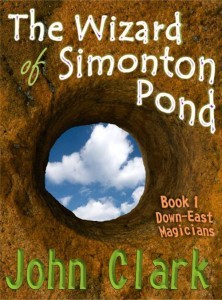
The first book
I jumped right into book two, Hither We Go, in which Berek ends up in a mental hospital because his mind not only can’t accept the emotional pain of what happened, but he feels used and betrayed as well as devastated because the way to Ballicore, the place halfway across the universe where he landed, has been destroyed. After getting discharged, he and his younger sister Kylin, have to figure out a way to save the family farm and once that’s done, Berek has a conversation with a field spider while raking blueberries. The spider (spiders in the series are able to communicate across vast distances) tells him that Elspeth, who he fell in love with in book one, has been kidnapped and in order to get back to Ballicore, he will need the assistance of two seemingly flawed companions. In hindsight, I think this might be the best book in the series.
Book three, Married With Familiars, finds Berek and Elspeth having to leave Ballicore very quickly because of the reason Berek was expelled at the end of book one. They are faced with finding a new place and decide to see if they can find a way to get to Senbec, a remote planet where Berek’s Uncle Leland found himself after being killed in the Maine wilderness by a falling tree. Berek has been able to communicate with him telepathically at intervals in the first two books. In Leland’s last message, he indicates that terrible things are happening on Senbec and he needs his nephew’s help. Easier said than done because Berek and Elspeth have to figure out where the planet is and how to get there. To do so, they must travel on the funkiest locomotive ever created through intergalactic space to COTU (The Center Of The Universe), an artificial planet that functions as the transport hub of intergalactic travel and is a cross between the city in Blade Runner and Diagon Alley. It also is where the Library of the Universe is, a way cool place run by the holographic image of a long dead and extremely sarcastic female librarian who takes an interest in the couple and goes the extra mile to help them The book ends on a really sad note.
When I started book four, Like A Thief in the Night: the Further Adventures of Kallista Wolfblood, I needed a break from Berek, so I focused this one on a delightful, but completely amoral thief and magic user who had been part of Berek’s cadre in book one. Her greed lands her in a most unusual situation that not only vexes the heck out of her, but forces her to examine everything she believes in. Most of the players in the first two books are reunited in this one which involves pirates and seriously evil folks from across the galaxy who are after something unique to Ballicore.
There was a gap of several years between the finish of book four and my beginning the last book in the series. That was in large part to how deeply my mother’s death hit me. I had no gas left in either the emotion or creativity tanks. Still, I knew I needed to wrap up the series if only to satisfy myself. That book, In My Father’s Footsteps, starts sixteen years later in a New Zealand rainforest, moves to the small town of Simonton, Maine and then jumps to Ballicore, but to a continent that Berek never explored. The protagonist rescues Gilraen, an Elven girl, and falls for her hard. However, even though she looks like a typical teen, albeit with pointed ears, she’s 110 (adolescent for her species), something that Josiah, the protagonist in this book, has a really difficult time wrapping his head around. Many of the earlier characters appear in this one, including the holographic librarian and Kallista. I haven’t gone back to editing it and know it’s clunky and needs a few characters deleted, but it does wrap things up nicely.

Wrapping up another day.
In the early days of writing this series, I created a website about the series that includes things like the history and geography of Ballicore. That link is below.
http://personalpages.tds.net/~berek/geography.html
What’s next? I have no clue. I’ve given some thought, based on subsequent writing efforts as well as reading a ton of YA fiction, that Berek might be better served if I made him brasher and more hip as well as moving it ahead a decade or so, but to do so would book five into the future as well as require rewriting close to a million words and I’m not that crazy or ambitious. Since book one is out there in ebook format, another dilemma is whether to release all of them (once I’m satisfied they’re as good as I can make them) as ebooks or try for getting them in print. Frankly, between my innate laziness (It’s a hell of a lot easier to sit on the back deck and get lost in one of the 100+ books from my TBR pile, than to put BIC) and my analysis paralysis, making decisions some days drives me crazy. Anyhow, this is an honest attempt to get stuff out of my head so maybe, just maybe, I’ll do something constructive with the series. In a perfect world, I’d lock myself in this room with a giant IV in the attic and simply edit all winter. I suspect a more moderate plan will emerge.
September 24, 2015
No Regrets
Jessie: In neighboring New Hampshire searching for wool socks.
 Two mornings ago my son had to scrape frost off his car before driving to school. Last Friday a friend brought me a ripe pumpkin she grew in her back field. Yesterday, my husband broke down and fired up the pellet stove in the kitchen to take off the chill. All signs indicate autumn is crouched and ready to pounce.
Two mornings ago my son had to scrape frost off his car before driving to school. Last Friday a friend brought me a ripe pumpkin she grew in her back field. Yesterday, my husband broke down and fired up the pellet stove in the kitchen to take off the chill. All signs indicate autumn is crouched and ready to pounce.
Truthfully, I don’t mind. I love summer and long, lazy days lolling at the beach. Grilled food is always on my list of favorites and I never tire of daylight lasting until nine p.m. But let’s face it, summer involves a lot of pressure, especially in New England.
In summer, everywhere you look something, or someone, is urging you to make the most of the season. If you happen to have been raised by parents from New England every sunny day reminds you of their exhortation to “Go out and play. You never know when it will be nice out again!”. Even when your adult obligations dictate you sit at a desk the guilt of squandering such a meteorological gift is crushing.
But autumn is more of a gentle soul. It kindly offers the pleasure of fall foliage, the first scented curls of woodsmoke, the comfort of slow-cooked stews and hot rolls fresh from the oven. It never clamors or demands you acknowledge its worth. It simply goes about its business until it fades away with a final rustle of leaves and a blanket of snow.
So, it’s with a light heart I plan to swap my sundresses for sweaters. I’ll replace lemonade with mulled cider and ice cream bars with pumpkin squares. Instead of tiki torches on the patio I’ll light candles in the dining room. I couldn’t be more pleased.
Readers, do you love fall? Or is another season your favorite? What is the best thing about fall in Maine or in your part of the world?
September 22, 2015
Makes Me Want to Kick the Cat
Kate Flora: It’s a darn good thing I don’t write cozy mysteries, starting out with a title
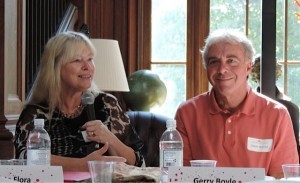
Kate Flora and Gerry Boyle during the panel titled “Sex Change” about writing a protagonist of the opposite gender
like that, right? Well, as another presenter at Murder by the Book this weekend put it, I write medium boiled mysteries in my Thea Kozak series, and pretty darned hard boiled in the Joe Burgess series. The audience on Friday night at the Jesup Library discovered that when I read part of the opening chapter of the next Burgess, And Led Them Thus Astray. No doubt about it, when he’s mad, Joe Burgess uses language I would never use. But there I was, swearing in front of a room full of strangers.
But that, of course, is not what this blog post is about. What it is about is something like (if you inclined to take it that way), an extended whine.
Yes! I have now revealed a deep, dark secret of crime writers: sometimes we whine. Sometimes we whine and dine. Mostly to (or with) each other. Occasionally to a close friend. Far more rarely—to you. Because after all, we want you to believe we are always even tempered, which is mostly true because we can get a whole lot out of our systems by writing crime. And we want you to believe that we are always successful, heaped with praise from our loving readers, and showered with cash from our devoted publishers.
Maybe I should stop right here, and leave you cherishing that notion.
 Actually, this blog might not be so much a whine as a question: What am I doing wrong? If I give up a glorious weekend, drive six+ hours, give “good value” on my panels and am cheerful, thrifty, clean, loyal, brave, and reverent, and at the end of the day, I’ve managed to sell two $8.00 paperbacks, this is not a viable economic model. What should I be doing instead?
Actually, this blog might not be so much a whine as a question: What am I doing wrong? If I give up a glorious weekend, drive six+ hours, give “good value” on my panels and am cheerful, thrifty, clean, loyal, brave, and reverent, and at the end of the day, I’ve managed to sell two $8.00 paperbacks, this is not a viable economic model. What should I be doing instead?
Stop saying yes, even though I love to talk about writing, love spending time with other writers, and so appreciate the hard work Jesup’s amazing librarians did to put on a great event and draw a crowd? Can I believe that all those lovely people will later log on and buy the e-book? Allow myself a temporary moment of discouragement and frustration?
So yes, as I sit here puzzling my way through how to organize the next book (having given up a couple hours today dealing with the SPOD, or spiraling pinwheel of death that wouldn’t open Microsoft Word), part of me wants to kick the cat. Fear not. I do not HAVE a cat. In one book, I gave Thea a stuffed cat to kick, and if I had one, that would suffice. I do have a stuffed moose…but who has ever heard of “kicking the moose?”
And then, having gotten it out of my system (and writing things out of our systems is why

Bacon, squid ink pasta, and hot peppers!
we crime writers usually are pretty cheerful) I shall go back to trying to find out who is killing those poor women and why he is using a sword?
And you—because you don’t want me to kick that moose—and because you are also cheerful and kindly and well-disposed toward helping writers stay published—will follow this link and order up a copy of a really fun, if slightly outrageous, book I wrote with Katy Munger, Lise McClendon, Gary Phillips, and Taffy Cannon: Beat, Slay, Love. Amazon: http://smarturl.it/BeatSlay
September 21, 2015
Burying the Lede
A groggy, bleary-eyed Chris Holm here. As I write this, my wife and I are recovering from a whirlwind road trip to Bar Harbor for the Jesup library’s inaugural Murder by the Book.
Despite some hiccups getting there (an actual, honest-to-god manhunt halted traffic on Route 3 and added nearly two hours to the drive), the event was a blast. The Jesup’s staff is as ambitious as they are enthusiastic, and they put together two days of fantastic programming, most of it free (which is darn near unheard of). And the setting, both town and library, was stunning. To cap it off, I got to spend time in the company of dear friends and talented writers (many of whom are featured in the sidebar of this blog), and meet loads of passionate readers. I hear tell the Jesup’s planning another Murder by the Book for next fall. Be sure to check it out.
Hmm. What else was I gonna tell you guys? I feel like there was something. Eh. Whatever it was, it couldn’t be that big a deal.
Oh, wait. I remember. THE KILLING KIND came out last Tuesday!
I can’t tell you how pleased I am it’s finally out in the world. There was a time I worried this book would never see the light of day. My prior agent was so unenthusiastic about it, she sat on the manuscript for nine months without reading it. Parting ways with her was one of the most difficult decisions I’ve ever had to make. It’s also proven one of the best, because thus far, the response to THE KILLING KIND has been astonishing. It’s garnered raves from NPR, Huffington Post, and the Maine Sunday Telegram. It’s been highlighted as a top read for September by Strand Magazine, Barnes & Noble, and MysteryPeople. For five crazy minutes, it was even a trending topic on Twitter.
Maybe the hype will continue to build. Maybe it’ll fade. But either way, I’m very grateful to everyone who’s helped me get to where I am today. Here are but a few who deserve my thanks. Most of all, I’m grateful to the readers, librarians, and booksellers who make it possible for me to live my dream. Without them, I’m just some nutball making up stories in my pajamas.
September 20, 2015
Cover Story’s Back Story
By Brenda Buchanan
In the beginning, Joe Gale was Marty Gleason.
This was eight or so years ago, when I sat down in my cramped study on Peaks Island, determined to write the book I’d been thinking about for many years. We’d decided to move to the mainland, and my intuition told me that enormous transition would be eased if I were already engaged in something that would feel as powerful and central to me as had my life as an islander.
I don’t think I wrote more than a chapter before we moved off Peaks. I looked out the window a lot, and did that ‘round and ‘round in circles thing, having no clue how to start writing a book. No bolt of insight arrived after we’d ferried all of our possessions across the water. But I remained committed to writing the mystery I’d been ruminating about since I’d left journalism for law school.
That long-ago conceived book—now called Cover Story—will be released a week from today, on September 28.
As it turns out, it’s not my first published novel, and there are good reasons for that.
My early drafts were amateurish. The manuscript improved in tiny increments as I navigated my way through numerous workshops, notably at New England Crime Bake. I also was fortunate to have the feedback of a good writer’s group.
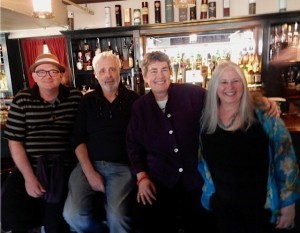
The writing group that helped me during early stages of COVER STORY – Richard Bilodeau, James Hayman and Jane Sloven
But after several years of steady work, there was no way around it—the manuscript, then called Relative Defense, had problems.
Several of the agents to whom I sent query letters or met at conferences offered constructive feedback. You know how to write, they said. But you’re making all the rookie mistakes.
Their eventual advice that I hated to hear? Set your manuscript aside and write another book.
Though painful, it was the right answer.
If I couldn’t accept that the book wasn’t what it needed to be, and if I couldn’t bring myself to set it aside and start a fresh book, then I’d be a person who fantasized about being a published author, but I’d never be one.
So I wrote another book. The result was Quick Pivot, the first book in the Joe Gale Mystery Series, which was released in April.
Early in the process of writing Quick Pivot I realized why those in the know had nudged me in the write-another-book direction. Though I hadn’t cracked my first manuscript’s particular code, I was starting from a different place. This was a critical revelation.
What had seemed so, well, mysterious the first time around was now less so. I’d figured out point of view. I’d gotten the hang of writing dialogue. I knew I could sustain a narrative arc for 350 pages.
I also learned that my characters were disgruntled about a few things.
It turned out my reporter protagonist was a one-syllable first name, one-syllable last name kind of guy. That’s when Marty Gleason became Joe Gale.
His diner-owning best friend Christie was Greek, not WASP, so her last name became Pappas instead of Perkins and she grew a stronger personality to match. Unfortunately, I had to kill off her live-in grandfather. He was a nice guy, but he made for one too many characters, so he had to go. And most importantly, Joe’s mentor Paulie Finnegan came out of the shadows, which is when Joe himself began to make sense. Why did a thirty-something newspaper reporter go at every story with old-school verve? Paulie Finnegan, that’s why.
When my agent offered me representation on the strength of Quick Pivot, I was thrilled. Then she asked if I had any other manuscripts in the drawer. My stomach did a couple of flips. It had been a long time since I’d touched that first book, and the chorus of “not readys” that had greeted it when I sent it out into the publishing world still rang in my ears.
But I heard myself saying, sure, I have another Joe Gale book, one where he goes to Machias to cover the trial of a man accused of killing a politically well-connected DHHS caseworker. It happens in the middle of a brutal Maine winter. When Joe reports that the evidence doesn’t match up with the pre-trial hype, he learns the hard way about Downeast-style intimidation.
That was the gist of the story I’d written, and it was enough to construct the pitch and plot summary she needed to sell my publisher on a three-book deal.
Before that happened I’d taken that first manuscript off the shelf and gone into overhaul mode. Nixed the sloooow beginning. Cleaned up wordy sentences. Added and subtracted characters. Juiced up flat chapter endings. More times than I can count I thought I was done. But every time I did a start-to-finish read with my newly critical eye, it was clear I needed to revise some more.
Last year, with additional insight from my brilliant editor, I finally got there. Next Monday, the first novel I conceived will come into the world.
The moral of this tale? For all but the most gifted among us, getting published takes years of steady work. To those who are laboring on your own first (or fifth) manuscript, I hope this post encourages you to stay with it.
And to everyone who helped me bring Cover Story into the world, this one’s for you.


